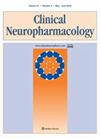奥克雷单抗治疗高度活动性多发性硬化症阿仑单抗后矛盾疾病活动性
IF 0.8
4区 医学
Q4 CLINICAL NEUROLOGY
Clinical Neuropharmacology
Pub Date : 2022-09-01
Epub Date: 2022-09-07
DOI:10.1097/WNF.0000000000000522
引用次数: 0
摘要
摘要:Alemtuzumab是一种人源化抗cd52抗体,注册用于治疗高活性复发-缓解型多发性硬化症。阿仑单抗治疗后疾病活动很少。这可能是由于中性自身抗体的发展导致淋巴细胞缺乏耗竭的结果。另一方面,阿仑单抗治疗后出现了严重的疾病活动,这可能是由b细胞过多引起的。我们提出了一例患有多发性硬化症的人在阿仑单抗给药后严重的疾病激活,这可能代表矛盾的B细胞介导的疾病活性。该患者成功接受ocrelizumab治疗。本文章由计算机程序翻译,如有差异,请以英文原文为准。
Ocrelizumab for Post-Alemtuzumab Paradoxical Disease Activity in Highly Active Multiple Sclerosis.
Abstract: Alemtuzumab is a humanized anti-CD52 antibody that is registered for treatment of highly active relapsing-remitting multiple sclerosis. Disease activity after alemtuzumab treatment is infrequent. It may be a result of lack of lymphocyte depletion due to development of neutralizing autoantibodies. On the other hand, severe disease activity has been described after alemtuzumab, which is suggested to be caused by B-cell hyperpopulation. We present a case of a person with multiple sclerosis with severe disease activation after alemtuzumab administration that may represent paradoxical B cell-mediated disease activity. The patient was successfully treated with ocrelizumab.
求助全文
通过发布文献求助,成功后即可免费获取论文全文。
去求助
来源期刊

Clinical Neuropharmacology
医学-临床神经学
CiteScore
1.20
自引率
10.00%
发文量
63
审稿时长
6-12 weeks
期刊介绍:
Clinical Neuropharmacology is a peer-reviewed journal devoted to the pharmacology of the nervous system in its broadest sense. Coverage ranges from such basic aspects as mechanisms of action, structure-activity relationships, and drug metabolism and pharmacokinetics, to practical clinical problems such as drug interactions, drug toxicity, and therapy for specific syndromes and symptoms. The journal publishes original articles and brief reports, invited and submitted reviews, and letters to the editor. A regular feature is the Patient Management Series: in-depth case presentations with clinical questions and answers.
 求助内容:
求助内容: 应助结果提醒方式:
应助结果提醒方式:


